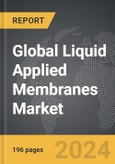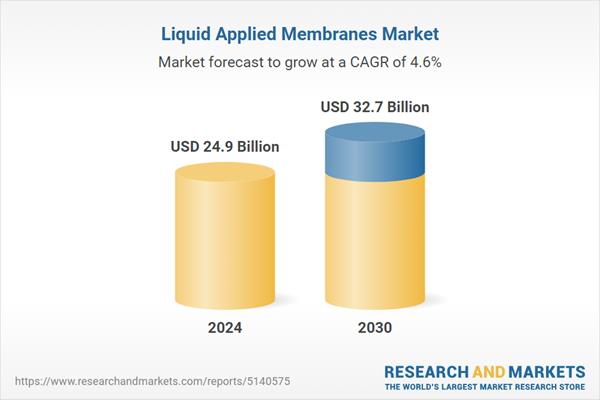The global market for Liquid Applied Membranes was valued at US$24.9 Billion in 2024 and is projected to reach US$32.7 Billion by 2030, growing at a CAGR of 4.6% from 2024 to 2030. This comprehensive report provides an in-depth analysis of market trends, drivers, and forecasts, helping you make informed business decisions. The report includes the most recent global tariff developments and how they impact the Liquid Applied Membranes market.
Segments: Membrane Type (Elastomeric, Bituminous, Cementitious); Application (Roofing, Building Structures, Walls, Other Applications); End-Use (Residential Construction, Commercial Construction, Public Infrastructure).
Geographic Regions/Countries: World; United States; Canada; Japan; China; Europe (France; Germany; Italy; United Kingdom; Spain; Russia; and Rest of Europe); Asia-Pacific (Australia; India; South Korea; and Rest of Asia-Pacific); Latin America (Argentina; Brazil; Mexico; and Rest of Latin America); Middle East (Iran; Israel; Saudi Arabia; United Arab Emirates; and Rest of Middle East); and Africa.
The analysts continuously track trade developments worldwide, drawing insights from leading global economists and over 200 industry and policy institutions, including think tanks, trade organizations, and national economic advisory bodies. This intelligence is integrated into forecasting models to provide timely, data-driven analysis of emerging risks and opportunities.
Global Liquid Applied Membranes Market - Key Trends & Drivers Summarized
Why Are Liquid Applied Membranes Gaining Popularity in the Construction Industry?
Liquid applied membranes (LAMs) are increasingly favored in the construction industry for their superior waterproofing and protective properties. These membranes, applied as a liquid coating, form a seamless, flexible barrier that protects structures from water infiltration, chemical exposure, and environmental damage. The popularity of LAMs is driven by their versatility, as they can be used on a wide range of surfaces, including roofs, foundations, and walls. Their ability to conform to complex shapes and provide continuous coverage without joints makes them particularly effective in preventing leaks and extending the lifespan of buildings and infrastructure. The growing emphasis on durable and sustainable construction practices is further boosting the demand for LAMs, as they contribute to the overall resilience and longevity of structures in various environmental conditions.How Are Technological Advancements Enhancing the Performance of Liquid Applied Membranes?
Technological advancements are significantly enhancing the performance and application of liquid applied membranes (LAMs), making them more effective, durable, and environmentally friendly. Innovations in polymer chemistry have led to the development of advanced formulations that offer improved adhesion, flexibility, and resistance to UV radiation, chemicals, and extreme temperatures. These enhancements are expanding the range of applications for LAMs, making them suitable for more demanding environments and challenging projects. Additionally, advancements in application technologies, such as spray-applied systems and self-leveling formulations, are improving the ease and efficiency of LAM installation, reducing labor costs and application times. The development of eco-friendly LAMs, made from renewable or recycled materials, is also gaining traction as the construction industry moves towards more sustainable practices. These technological improvements are driving the adoption of LAMs in both new construction and renovation projects, supporting market growth.What Market Trends Are Driving the Demand for Liquid Applied Membranes?
Several key market trends are driving the demand for liquid applied membranes (LAMs), including the growing focus on sustainable construction, the need for effective waterproofing solutions, and the expansion of infrastructure development. As the construction industry increasingly prioritizes sustainability, there is a rising demand for building materials that offer long-term durability and environmental benefits. LAMs, with their ability to extend the lifespan of structures and reduce maintenance needs, align well with these goals. The ongoing expansion of infrastructure projects, particularly in emerging markets, is also boosting demand for LAMs, as they are essential for protecting bridges, tunnels, and other critical structures from water damage and environmental stressors. Additionally, the trend towards green building certifications and energy-efficient construction is supporting the growth of LAMs, as these membranes contribute to the overall sustainability and performance of buildings.What Is Driving the Growth in the Liquid Applied Membranes Market?
The growth in the liquid applied membranes (LAMs) market is driven by several factors. The increasing demand for durable and flexible waterproofing solutions in the construction industry is a major driver, as LAMs provide superior protection against water infiltration and environmental damage. Technological advancements in LAM formulations and application methods are enhancing product performance and ease of use, further driving market growth. The growing emphasis on sustainable construction practices and the need for materials that contribute to the longevity and resilience of structures are also supporting the adoption of LAMs. Additionally, the expansion of infrastructure projects in developing regions, where durable and cost-effective waterproofing solutions are in high demand, is creating new opportunities for LAM manufacturers. The rising trend of building renovations and retrofitting, particularly in mature markets, is further fueling the demand for LAMs, as these membranes are ideal for enhancing the durability and performance of existing structures.Report Scope
The report analyzes the Liquid Applied Membranes market, presented in terms of units. The analysis covers the key segments and geographic regions outlined below.Segments: Membrane Type (Elastomeric, Bituminous, Cementitious); Application (Roofing, Building Structures, Walls, Other Applications); End-Use (Residential Construction, Commercial Construction, Public Infrastructure).
Geographic Regions/Countries: World; United States; Canada; Japan; China; Europe (France; Germany; Italy; United Kingdom; Spain; Russia; and Rest of Europe); Asia-Pacific (Australia; India; South Korea; and Rest of Asia-Pacific); Latin America (Argentina; Brazil; Mexico; and Rest of Latin America); Middle East (Iran; Israel; Saudi Arabia; United Arab Emirates; and Rest of Middle East); and Africa.
Key Insights:
- Market Growth: Understand the significant growth trajectory of the Elastomeric segment, which is expected to reach US$17.7 Billion by 2030 with a CAGR of a 4.6%. The Bituminous segment is also set to grow at 5.1% CAGR over the analysis period.
- Regional Analysis: Gain insights into the U.S. market, valued at $6.6 Billion in 2024, and China, forecasted to grow at an impressive 6.9% CAGR to reach $7.1 Billion by 2030. Discover growth trends in other key regions, including Japan, Canada, Germany, and the Asia-Pacific.
Why You Should Buy This Report:
- Detailed Market Analysis: Access a thorough analysis of the Global Liquid Applied Membranes Market, covering all major geographic regions and market segments.
- Competitive Insights: Get an overview of the competitive landscape, including the market presence of major players across different geographies.
- Future Trends and Drivers: Understand the key trends and drivers shaping the future of the Global Liquid Applied Membranes Market.
- Actionable Insights: Benefit from actionable insights that can help you identify new revenue opportunities and make strategic business decisions.
Key Questions Answered:
- How is the Global Liquid Applied Membranes Market expected to evolve by 2030?
- What are the main drivers and restraints affecting the market?
- Which market segments will grow the most over the forecast period?
- How will market shares for different regions and segments change by 2030?
- Who are the leading players in the market, and what are their prospects?
Report Features:
- Comprehensive Market Data: Independent analysis of annual sales and market forecasts in US$ Million from 2024 to 2030.
- In-Depth Regional Analysis: Detailed insights into key markets, including the U.S., China, Japan, Canada, Europe, Asia-Pacific, Latin America, Middle East, and Africa.
- Company Profiles: Coverage of players such as Compact Membrane Systems, GCP Applied Technologies, Inc., Henry Company, Johns Manville, Kemeper Systems America Inc. and more.
- Complimentary Updates: Receive free report updates for one year to keep you informed of the latest market developments.
Some of the 46 companies featured in this Liquid Applied Membranes market report include:
- Compact Membrane Systems
- GCP Applied Technologies, Inc.
- Henry Company
- Johns Manville
- Kemeper Systems America Inc.
- Nanjing Tangent Fluid Technology Co., Ltd.
- Ultrafilter (India) Pvt., Ltd.
Tariff Impact Analysis: Key Insights for 2025
Global tariff negotiations across 180+ countries are reshaping supply chains, costs, and competitiveness. This report reflects the latest developments as of April 2025 and incorporates forward-looking insights into the market outlook.The analysts continuously track trade developments worldwide, drawing insights from leading global economists and over 200 industry and policy institutions, including think tanks, trade organizations, and national economic advisory bodies. This intelligence is integrated into forecasting models to provide timely, data-driven analysis of emerging risks and opportunities.
What’s Included in This Edition:
- Tariff-adjusted market forecasts by region and segment
- Analysis of cost and supply chain implications by sourcing and trade exposure
- Strategic insights into geographic shifts
Buyers receive a free July 2025 update with:
- Finalized tariff impacts and new trade agreement effects
- Updated projections reflecting global sourcing and cost shifts
- Expanded country-specific coverage across the industry
Table of Contents
I. METHODOLOGYII. EXECUTIVE SUMMARY2. FOCUS ON SELECT PLAYERS3. MARKET TRENDS & DRIVERSIII. MARKET ANALYSISCANADAITALYSPAINRUSSIAREST OF EUROPESOUTH KOREAREST OF ASIA-PACIFICARGENTINABRAZILMEXICOREST OF LATIN AMERICAIRANISRAELSAUDI ARABIAUNITED ARAB EMIRATESREST OF MIDDLE EASTIV. COMPETITION
1. MARKET OVERVIEW
4. GLOBAL MARKET PERSPECTIVE
UNITED STATES
JAPAN
CHINA
EUROPE
FRANCE
GERMANY
UNITED KINGDOM
ASIA-PACIFIC
AUSTRALIA
INDIA
LATIN AMERICA
MIDDLE EAST
AFRICA
Companies Mentioned (Partial List)
A selection of companies mentioned in this report includes, but is not limited to:
- Compact Membrane Systems
- GCP Applied Technologies, Inc.
- Henry Company
- Johns Manville
- Kemeper Systems America Inc.
- Nanjing Tangent Fluid Technology Co., Ltd.
- Ultrafilter (India) Pvt., Ltd.
Table Information
| Report Attribute | Details |
|---|---|
| No. of Pages | 196 |
| Published | April 2025 |
| Forecast Period | 2024 - 2030 |
| Estimated Market Value ( USD | $ 24.9 Billion |
| Forecasted Market Value ( USD | $ 32.7 Billion |
| Compound Annual Growth Rate | 4.6% |
| Regions Covered | Global |









